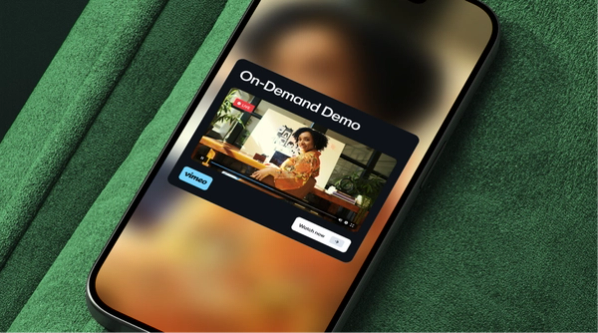
Connected TV (or CTV) advertising allows marketers to deliver ads to smart TVs and similar platforms with streaming and online programming. It has the same kind of reach as traditional TV advertising with better tracking and analytics. According to Kirsten van Rooyen, Head of Video Strategy at Superside, that’s just part of what makes it a strong marketing channel in 2024.
Do you have a cable subscription right now? It turns out that the answer to that question is comparable to a coin flip. About 60 million American households pay for television, which represents just under 50% of them. So it makes sense that all the advertising dollars that used to go into cable television are going somewhere else. But it’s not all going to social media ads or similar channels.
A growing portion of it is going to CTV (connected TV).
So, what is this burgeoning media channel? And how can you get in on the ground floor? Here are some insights into this new advertising channel from Kirsten van Rooyen, Superside’s Head of Video Strategy.
What Is CTV Advertising?
Connected TV advertising is any sort of streaming or online programming that comes through a device like a smart TV. That means everything from traditional cable shows to live streams counts as CTV if it’s watched on a smart TV.
For the end consumer, CTV advertising is pretty similar to the ads they used to get during the breaks in their TV programming back in the cable days.
For marketers, though, it’s a completely different game. Buying ad space is different, optimizing it is different, and there are some specifics about the format and audience you have to keep in mind when planning CTV ads.
An example of CTV marketing for B2B is the use of videos featuring Ryan Reynolds, a renowned Hollywood actor and Chief Creative Officer at MNTN. In these videos, Ryan talks about how B2B marketers can leverage the company’s proprietary CTV ad platform. Then, the ad is streamed on networks such as popular streaming services (Hulu, Sling TV, etc.) and apps from broadcasters like CBS and Fox.
What’s the difference between OTT and CTV advertising?
Generally speaking, OTT (over-the-top) advertising refers to any ads placed on media services offered directly over the internet—like Netflix, Hulu, or YouTube TV. CTV advertising, meanwhile, refers to placing ads specifically on smart TVs that use OTT advertising services. That means when you’re building a CTV ad campaign, you’re thinking specifically about how it’s going to look on a TV.
5 Benefits of CTV Advertising
CTV advertising is more than just another channel brands have to worry about. It marries some of the advantages you’ll find in channels like Facebook and Google ads with the reach of TV advertising. It also has unique benefits.
1. It’s early
Ever wish you could have gotten in on TikTok early? What about Facebook advertising? Well, if you missed out on your chance to get in on the ground floor for these platforms, CTV might be the next big video marketing trend to bet on. While people have been cutting the cord for years, now, advertising on these platforms is still in its early stages. Now, with Amazon having just added ads to Prime Video—and likely revealing more updates as the year progresses—you have the opportunity to get ahead of the gold rush.
2. Better targeting
When you buy TV advertising, there’s never a strong guarantee that your ad will reach your target audience. Despite the targeting information you are given by a network, your ad will run in front of whoever happens to be watching a particular program at that time. CTV ads have the same kind of rigorous targeting you’d find on social media platforms, especially if you’re buying ads using services like Amazon Ads.
3. Integrated (or at least faster) shopping
While it’s still a bit early for this, we could realistically see integrated shopping in CTV—a bit like what you’ll find on YouTube and TikTok already. Imagine being able to add a link to your call to action right in your CTV ad, the way you might on social media?
Even if integrated shopping isn’t quite there yet for CTV, it’s a lot easier for someone to make a purchase decision on a smart TV than on regular TV programming.
4. Optimization
Know what you can’t do on traditional cable advertising that you can on CTV? Optimize your ads over time. Generally speaking, when you buy ad space on TV, whatever you give them is what’ll show up on air. You usually can’t modify your connected TV ads based on the data you’re getting back over your campaign’s lifetime. While that might sound like a nightmare for anyone who’s used to getting ad space online, don’t worry, with CTV, you can change your ads on the fly.
5. Cross-device advertising
If you believe that CTV advertising is confined to the basic functions of a traditional TV, think twice–Smart TV content can be broadcast through various channels and platforms, extending from stand-alone streaming devices to gaming consoles. 62% percent of people aged 18-34 watch video on a TV via a connected device daily, and 87% of US TV households have at least one Internet-connected TV device.
This cross-device targeting approach enables advertisers to reach people on different devices while using the same streaming platforms. By utilizing information such as email addresses and device IDs, it’s possible to follow users as they switch between devices, ensuring a personalized and reliable experience, no matter which CTV device they choose for watching digital content.
How Does CTV Advertising Work?
A CTV advertising campaign follows the same essential steps as any other channel. You set out a goal for your campaign, create the ads, then buy the ad space for them.
The differences really come in how that purchase actually happens, especially when compared to ad providers like Facebook and Google, where everything is centralized.
How buying CTV advertising works
When you buy CTV ad space you essentially have three options. Each can offer you reach on different platforms, different prices, and often a different audience. These three buying options are:
- Programmatic: This method of buying CTV advertising involves going through providers that offer ad space on multiple platforms through auctions. Much like you would on Google Ads, you “bid” for specific ad spots, with the provider choosing a winner through an automated process that takes less than a second. These platforms are usually only available to selected advertising partners, unlike the two other methods.
- Platform: Instead of dealing with a programmatic provider, you can go directly to a platform like Roku, Xbox, or LG, and buy ad space. This means your campaign will only be visible on these platforms, but in some cases that’s actually a plus. For example, an ad campaign targeting gamers of a certain age will do better when delivered through an Xbox than something like YouTube.
- Publisher: For CTV advertising, a “publisher” is any party that provides an OTT service. That includes the likes of YouTubeTV, iTunes, and DirecTV. This can give you a wider reach through multiple platforms, though campaigns with ad space bought primarily from publishers won’t necessarily be delivered through smart TVs and similar devices.
15 examples of CTV advertising sellers
Not sure where to go to start planning your CTV campaign? Here are just a few examples of providers you can buy CTV advertising space from.
- Eskimi
- Tatari
- Simulmedia
- Moloco
- Roku
- Fire TV
- Android TV
- Xbox
- Amazon Prime Video Ads
- Samsung
- LG
- GoogleTV
- YouTubeTV
- The CW
- Google Play
This list has a mix of programmatic providers, CTV advertising platforms, and publishers. Use it as a launching point when planning your CTV campaign.
Tips To Keep in Mind When Advertising on CTV
Now that you know the what, the why, and the how, let’s cover some things you should keep in mind when planning your CTV advertising campaigns with advice from Superside’s Head of Video Strategy.
Put extra focus on targeting
Understanding your target audience is crucial. CTV platforms often provide advanced targeting capabilities based on user preferences, viewing habits, and demographics. Personalizing ads to fit these characteristics can significantly enhance engagement and effectiveness

CTV advertising isn’t like linear TV advertising; you don’t have to guess if you’re targeting the right audience. By leveraging every bit of targeting a CTV ad seller offers, you can massively increase your campaign’s ROI.
Tailor your creative to the platform
The format of the ads (e.g., video, interactive ads) and the creative strategy should be tailored for CTV viewing experiences. Since CTVs are typically watched on larger screens and in a more relaxed environment than mobile or desktop, the ad content should be engaging and visually appealing to stand out in this context. Think of the way you approach TV - sound on, land the brand and have a CTA.

The best creative isn’t one-size-fits-all, it’s built with a specific platform in mind. To ensure you’re building a campaign that works, spend some time consuming CTV programming to see what kind of ads perform best on these platforms.
Use analytics to optimize your approach
Utilize the sophisticated analytics tools available on CTV platforms. Tracking metrics such as view completion rates, engagement, and conversion helps in understanding the effectiveness of the campaigns and in making data-driven decisions for future advertising strategies.

Because CTV advertising allows you to optimize your campaign as it runs, avoid having a “set-it-and-forget-it” approach. The best marketing campaigns are reactive, meaning they shift and change based on data to stay relevant for as long as possible.
Integrate CTV advertising with the rest of your campaign
CTV advertising should be integrated with broader marketing campaigns. Consistency across channels (like social media, web, and mobile) ensures a cohesive brand message and can amplify the overall impact of your marketing strategy.

While CTV advertising is a fascinating, exciting new channel, it’s not the end-all-be-all of your marketing campaigns. It works best as just one element of a broader campaign, especially when you can create a consistent video experience across channels.
Get in Early and Make It Big with Connected TV Advertising
CTV advertising pairs some of the best parts of traditional cable advertising (like its reach) with the benefits of more modern advertising channels (like Google and Facebook ads). As long as you apply the fundamentals of online marketing while keeping the unique aspects of the format in mind, you’ll have a successful campaign.
But you don’t have to give up on this channel just because you don’t have the right expertise in-house. With Superside, you can get expert advice at any stage of your campaign, and deliver CTV ad campaigns that always make an impact.
















